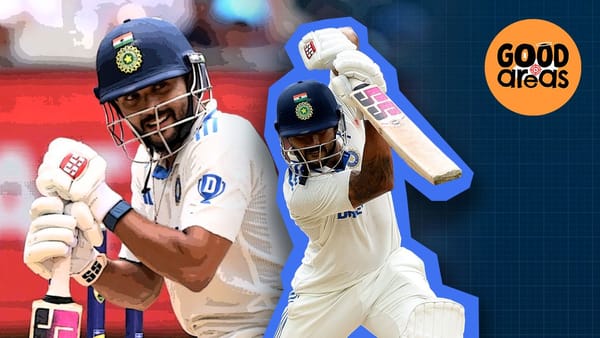The three versions of Kemar Roach
Roach is nothing like the bowler we saw when he was young, but he's found a new way to be fantastic.
This ball lives in my mind.

When Kemar Roach started a ball a mile outside leg stump and swung it to take Mark Stoneman’s top off.
Other than the beautiful shape here, this was around when Kemar’s comeback started. Because in Test cricket here have been three versions of Kemar Roach.
The first coming of Kemar Roach was hell on wheels. The early part of his career he bowled at 90 miles per hour, was close to the stumps, and moved the ball both ways. That was a solid gold 400 wicket Test bowler right there.
Something pretty big was going to have to happen to stop that. And it did, injuries. At first normal fast bowling ones, and then it was a car accident.
“Roach, 25, crashed his BMW sedan after losing control due to slippery road conditions at traffic lights near Wanstead Drive, just outside Bridgetown. According to local reports, the car flipped several times before landing in the 3Ws Park, approximately half a mile from the 3Ws Oval.
Two wheels of the vehicle were broken off and the airbags deployed reports stated. Roach sustained a head wound but appeared coherent as he was taken by ambulance from the scene. Roach took to Twitter a few hours later after the accident to reveal to follows that he was recovering and in good health. “Sorry To Scare My Friends, Family And Fans But I’m Straight! Thanks For The Love! #BlessUp.”
Roach flipped his car several times, which sounds pretty dramatic, and had some head and neck injuries. But he tweeted soon after to say he was fine. He has downplayed the incident since publicly.
It’s possible that wasn’t the injury that changed everything. Before the car accident, he broke his shoulder on an Indian tour. A very uncommon occurrence for a bowler. But whatever it was, Roach changed what he was over time.
But at his best, it was brutal.
Before this, it was Roach giving out the injuries. This is him against Jacques Kallis, around the wicket, into his face, like a boss. This was a brutal one.

But there was something even better. Roach one made Ricky Ponting retire hurt.

Another fast short ball slammed into Ponting’s arm, who actually tried to bat on, before eventually being taken to hospital for his arm. Ricky Ponting doesn’t retire hurt easily. Roach sent him to hospital.
This is the same Ricky Ponting getting hit in the face from a quick when batting in a cap and batting on.
Ponting was really the last player in the game to wear a cap consistently when facing quick bowling. We are talking about two of the best players of fast bowling ever, and young smacked one in the face and sent the other to the x-ray machine.
Just in case you’ve forgotten, Kallis is number 3rd on the all-time run scorers and Ponting is number 2nd, and both came from places where fast and short bowling was the norm. The point is, Kemar Roach had serious heat at this point.
And he had quite a few wickets.

85 of them at just under 28. If you’re new to cricket, you might be thinking, well, that isn’t that special. From 2009 until his car accident, Roach had the 11th best average. Not bad when considering no other West Indian was averaging better than 30, and their next best bowler was probably Shane Shillingford, who only played 16 Tests before being called for an illegal action.
And while he might look like a new ball killer now, back then, he was at his best with the old ball with the extra pace.

His numbers are very close to Dale Steyn’s in that period, if you find your record like his, you should consider it a life well-lived.
In one day cricket, he was not quite as good, but still excellent. Anyone who can maintain a bowling average under 30 while going at less than five an over is doing pretty well, really doing two jobs for one bowler.
It’s clear the first Kemar Roach was pretty tasty, well if that was at his best, then at his worst he was almost unplayable. (Not in a good way). In seven Tests over 2015 and 16 he took four wickets at 150. This is the period he was clearly in development, trying to match what he once did to what his body was allowing of him now. For two years, Roach looked broken, and you wouldn’t have bet on him coming back any near the level of before. .
We have the shoulder injury and the car accident. And all the other small things, and it’s clear that things have changed. CricViz’s data over the last few years suggests he has gradually gone 30cm wider on the crease, although that data was still in its infancy when he started.

The gap between where he bowls now and where he was bowling in 2009 looks closer to 60cm than 30. Roach told Sky, in 2017, him coming wider was a technical problem brought on by all the injuries, after I sent Sky some videos of before and after. It was clear he was still trying to make it work.
And by 2017, something had changed, and from then until now, we have the final Kemar Roach incarnation.
Recently a Test player asked me if I thought Kemar Roach was better than Ian Bishop. I laughed, not least because peak Ian Bishop might have been the best West Indian quick.

Joel Garner’s height combined with Andy Roberts’ brain and Malcolm Marshall’s swing. But we barely saw it. Even his 161 wickets at 24 seem like an underachievement. You just don’t get bowlers that fast, that tall with that much swing in the same body.
Kemar Roach was probably as quick as Bishop, and he swung it just as much but at a far lower release point. 23 centimetres lower based on their height, but when you factor in Bishop’s arms and good crease posture, it might have been more.
Not is he just way shorter than Bishop, but he also falls over when he delivers. And when injuries slowed Bishop down, he was still massively tall. When they slowed Roach down, he was massively short.

You can also see how correct Bishop was, he was good at using the crease, but when needed he got it real close. This was someone who could lose pace and be fine at Test level. You wouldn’t think the same with Roach.
A short slow bowler coming from wide of the wicket is not exactly a dream package. If he hadn’t been so good before, I don’t think the West Indies would have been in a rush to get him back, or given him as many chances to prove himself.
Perhaps the big change was as Roach, and all fast bowlers, pitched up at least a metre fuller. It meant that he could hit the stumps more. At the same point, umpires stopped worrying about bowlers coming wide when giving out LBW, as Hawkeye retained them. And in a DRS world, a short bowler hits the stumps a lot.
So how has that new Kemar Roach done. Well, if you look at it since 2017 it would suggest he has been at his best for a very long time.
However, that first period was really tough for bowling, and the second was not. So despite averaging 27 compared to 24, he was actually better in the first period.

In this period, while he has clearly been exceptional. So has everyone. So he was the 11th best bowler in that earlier era, he’s now the 16th. The fact he has been this good in two eras, as essentially two different bowlers, is something on it’s own. Also having a long term career in the West Indies over the last decade would be nearly impossible.
But not only does he look like a different bowler, he is actually a different bowler. For instance, from 09 to 2014, Kemar Roach was absolutely terrible against left-handers. And by terrible, I mean he was the worst high usage bowler to them.

This is about as dramatic a turnaround as you can get.

And part of it is just because he used to swing the ball away more, and now he swings it in. In fact, according to Cricviz he swings the ball away from left-handers the seventh most in Tests. However, of those in front of him, five are left-armers, so they are swinging it their natural way. Only Ishant Sharma of the right0armers swings it further from the southpaws.
Of course everyone is pretty good to lefties now, so as much as Roach dominates them, he’s still only the sixth-best, if you cut out to the two off-spinners, he’s still only fourth.
Although it’s worth just looking at how many people have started dominating the southpaws in this era. But a part of that was down to right-arm bowlers coming around the wicket.
And Roach has one of two bowlers to deliver over 2000 deliveries around the wicket to them, with Stuart Broad. But despite having this huge number of deliveries bowled, he also has the highest percentage of around the wicket to left-handers.

And this in an age when everyone bowls from there. Taskin Ahmed is the only right-arm seamer with 250 balls to southpaws who hasn’t bowled around the wicket once in this period. Also he averages over 100 against them, so he should try something new. Roach averages 21.23 around the wicket.
And it’s not just to the cack handers, he’s also changed how he dismisses righties, taking them LBW far more often than before.
This is an entirely different bowler from the one we first saw.
And he’s been outstanding in both parts of his career. He has ended up with the seventh most wickets in West Indies is an extraordinary effort. And look at the names that he will likely go past, Michael Holding and Joel Garner; behind him on the list is Garfield Sobers, and then Wes Hall is near too.
Maybe if you were optimistic like me, you could say that you thought this was possible when he was young. But when you look at how his body fell apart, the couple of years it took to recreate himself, and then the fact he came back as a slower wider inswing bowler, and actually got better is remarkable.
He doesn’t break arms and smack jaws anymore, but he does break hearts and smack the stumps. It’s different, but it still works pretty well.

That was a fantastic hundred by Joshua Da Silva. Earlier this match he jokingly called himself the worst keeper in the world. He let through 18 byes on day one, including balls going through his legs.
— Jarrod Kimber (@ajarrodkimber) 4:21 PM ∙ Mar 26, 2022
And to even out this, Da Silva walked in at 95/6, lost his last specialist batting partner at 128. He then carried three tailenders, in three different kinds of partnerships towards a good score.
— Jarrod Kimber (@ajarrodkimber) 4:21 PM ∙ Mar 26, 2022
He also had to handle the second new ball, twice, once at night and then again in the morning. Oh, and the first time, he was batting in the fading light.
— Jarrod Kimber (@ajarrodkimber) 4:21 PM ∙ Mar 26, 2022
Then he was going towards his maiden hundred when his club cricket mate suddenly decided to lash out a big hit against the spinner.
— Jarrod Kimber (@ajarrodkimber) 4:21 PM ∙ Mar 26, 2022
Through all of this Da Silva was careful, and has been - by far - the best batter on this pitch, and makes a hundred batting at number eight. No wonder he's in tears, what a knock.
— Jarrod Kimber (@ajarrodkimber) 4:21 PM ∙ Mar 26, 2022




